
Home |
Academy |
"little" Tony |
Online Store |
Videos |
Blog |
Seminars |
Programs
|
Gallery |
Contact |
Soulfight.net All Rights Reserved 2004-2011
Blog
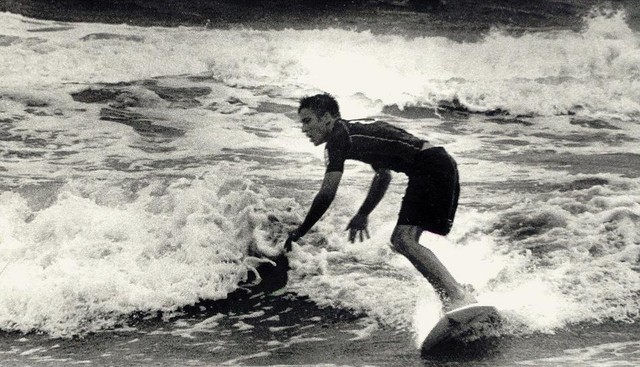
Sun-block, Surf Wax, Strength and Kimonos
The water was a little cold as my feet stepped slowly on the rocky beach. I had my surfboard in my hands and Jiu-Jitsu kimono in my friend's car right next to some sun block and surf wax. There was a smile on my face because I knew I finally made it back to California by way of Philadelphia. As I jumped through the air and landed on my board just over the white water moving quickly underneath me, I realized that I had been away from my second love far too long. When I made it out to the surfing lineup with surfers that looked so skilled and after paddling myself far from the beach, I could only take a deep breath and loosen my neck and back muscles, which were being worked in the surf. Maybe I wasn't in as good of shape after all. Jiu-Jitsu training alone hadn't prepared me for these waves that were 3 to 4 feet high over head. After two hours, I returned to the beach with sore arms and small cuts on my ankles. All I could think about was getting some Mexican food and sitting back to watch the sunset.
When I was finishing my surfing experience with my friends (by the way one of them broke his surfboard in half) I started to think about all the Brazilian Jiu-Jitsu fighters that surfed too. Rickson and Royler Gracie came to mind first, and then there was Relson Gracie; I knew he surfed as well. What was it that makes these Gracie fighters and many others hit and charge the waves? Now writing about how surfing improves your balance, and how in jiu-jitsu you need balance, is not really how I think surfing can improve one's performance on the mat; however, personally, I am more relaxed on the mat when surfing is present in my life. Nonetheless, being able to standup on a surfboard and express oneself without wiping out in the ocean takes a lot of skill. This type of skill, realistically, can improve anyone's abilities to even to walk straighter.
Recently I took a seminar with Royler Gracie. He was excited to see that I was into surfing. He even asked me about it and showed me a picture of him riding a wave from a book that he was signing for another student. Royler had that look in his eye because he knew that I knew about the feeling of being in sync with the ocean or watching something that is so very fast move so very slow. Maybe that is what draws all people to surfing, not just jiu-jitsu fighters.
As a Jiu-Jitsu stylist or grappler, I am always reading about how important it is to have a strong neck and back. My experience surfing this summer shows that paddling under and over waves strengthen my neck and back muscles in an exciting way. Other byproducts of surfing were having stronger arms and better conditioning. I love to train jiu-jitsu and I love surfing. Surfing has given me a way to strengthen the muscles that are important to jiu-jitsu. And jiu-jitsu has given me and blesses me with the confidence to control myself and avoid fighting with other surfers when the concept of localism shows its ugly face. I recommend learning and passing on a good thing; by the way, I am not talking about Martial Arts!
-Written 2004- Tony Pacenski
To Pass or Not To Pass
Part 1
Passing the guard position in Brazilian Jiu-Jitsu (BJJ) can be
one of the most challenging positions to conquer during a match or on the
mat during training. It has become commonplace to watch tournament matches
decided on who passes the guard and who doesn't pass the guard. Because
such a great amount of time is spent to learn how to use the guard
effectively and how to pass it, students are taught from week one to open
the opponent's
ankles and use fundamental methods to pass the guard. Over the years from
white belt through brown belt, I have learned and relearned, learned and
unlearned many different types of guard passes both on the knees and
standing up. One question I had to answer was: How does a new student know
which methods of guard passing works the best if there are so many to choose
from?
Students learn very quickly that each person's style of jiu-jitsu is
different. And I can hear it as if it was yesterday my instructor saying,
"Each
student in class will learn jiu-jitsu and have his or her own style of
applying it."
However, all of us needed to begin somewhere;
we needed to learn the basics in passing the guard. These A, B, C's
were necessary so that we could make the words, then sentences, and finally
paragraphs to express ourselves just as a good writer does. My problem as a
white belt was that I could never seem to open the guard, let alone pass
it. Therefore, my instructor taught the basic kneeing or sitting guard pass
instead of standing up to pass the guard to me. I later found out it was
easier for me to open my opponents legs when standing up, yet passing on my
knees worked great until the other students picked up on the triangle
choke. After Royce Gracie used the technique to win against Dan
"The Beast"
Severn in the Ultimate Fighting Championship IV, it was the new popular move
to do. So there I was being triangle choked by the upper level students and
blue belts. Wow, I was intimidated too! When I was on the knees to pass
the guard, I wanted to learn everything I could on how to defend the
triangle choke that way I could escape it.
USING THE CLASSICAL GUARD PASS
(1.) Tony begins in the guard, holding the belt and arm of the opponent.
(2.) Using the classical pass, Tony steps up with the foot and brings his arm through the hole created between the opponent's legs.
(3.) Here Tony was able to grab the collar on the far lapel and move pressure towards the head of the opponent using his legs.
(4.) Continuing by bringing the knee down, Tony uses his other foot to drive forward causing discomfort to the opponent.
(Is Tony Passing the Guard or Escaping the Triangle Choke position?)
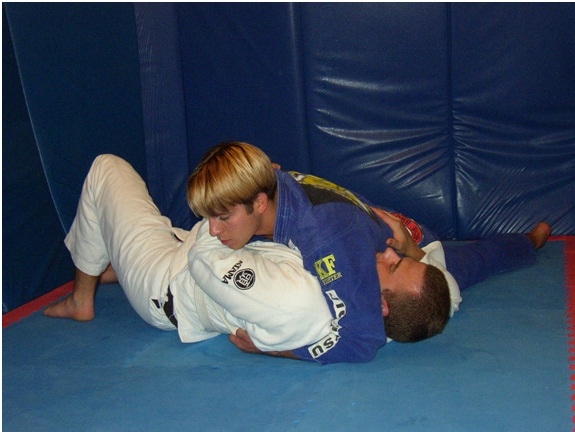
(5.) With good pressure Tony was able to break the ankles of the opponent,
letting the legs pass his head and finalize the cross body position.
For the next couple of months I changed my strategy and started to stand up
to pass hoping that I could avoid the triangle choke all together. There
were a couple of good students at my academy known for tapping people out
with their triangle, so I could challenge and research how well I was doing
standing up. The thing was I would get caught and sometimes I would pass the
guard. I was learning and discarding methods of passing and escaping that
did not work well for me. All of this took time and it helped that new
instructors were visiting the academy teaching different techniques in
passing the guard. Or did it?
If I was under the understanding that each student has a different
expression of the art, so does each instructor have different approaches and
methods in teaching the positions of jiu-jitsu. I loved learning new guard
passing methods, but I disliked unlearning techniques. Each instructor had
a new twist to passing the guard that I picked up to modify my sitting guard
pass. They would say, "Look
trying doing it this way."
The basic problem in having different
guest instructors visit your academy is so many different techniques and
strategies can often confuse a student in what works best for him or her.
Moreover, just because your instructor's
BJJ works well from him doesn't
mean it will work best for you. For me I would just think,
"Man this
isn't working for me, but I do grasp the concepts.
I do see jiu-jitsu a little different now from this experience."
By this time, during my blue belt years, I had learned there was more to
defend other then the triangle choke in attempting to pass the guard. There
were the armlocks, sweeps, and the Omoplata
position that worked well in combination with the triangle choke. Looking
back it was important to learn everything I did from the different
instructors even if I had to unlearn good habits and bad habits. I put my
time in getting triangle choked, yet I learned to counter it effectively and
later how to correct my method of passing to avoid it. I sat there one day
thinking, "Am
I passing the guard or am I countering the triangle choke?"
There is a difference.
AVOIDING THE TRIANGLE CHOKE
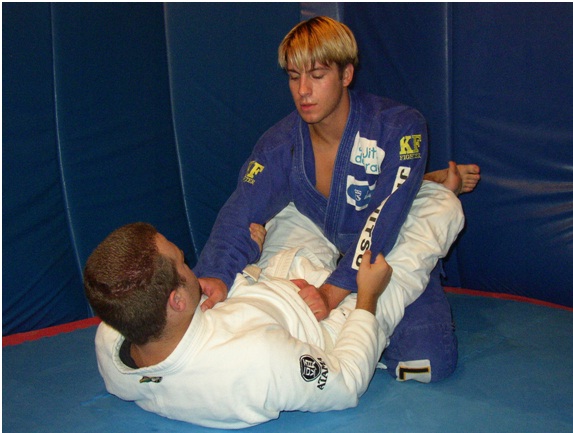
(1.) Here Tony begins by holding the two lapels with one hand pushing the
chest. His other hand holds the belt to gain good posture.
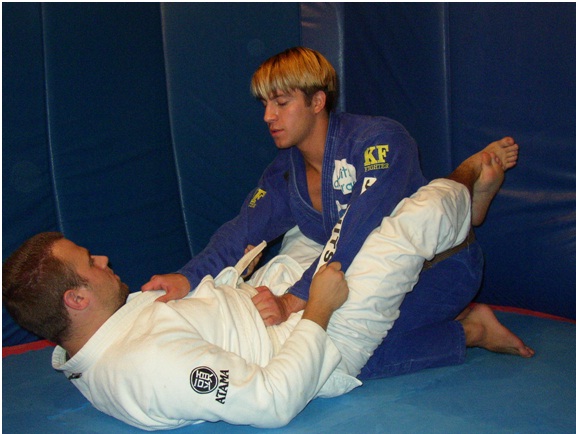
(2.) Instead of stepping the left foot up as in the classical pass, Tony
brings his knee against the opponent's bottom in the center. Tony's
other knee or foot positions out for balance on the far side.

(3.) Next Tony wishes to bring his right hand off the chest of the
opponent; however, the opponent holds the sleeve to counter. Tony simply
uses a circular motion to break to grip.
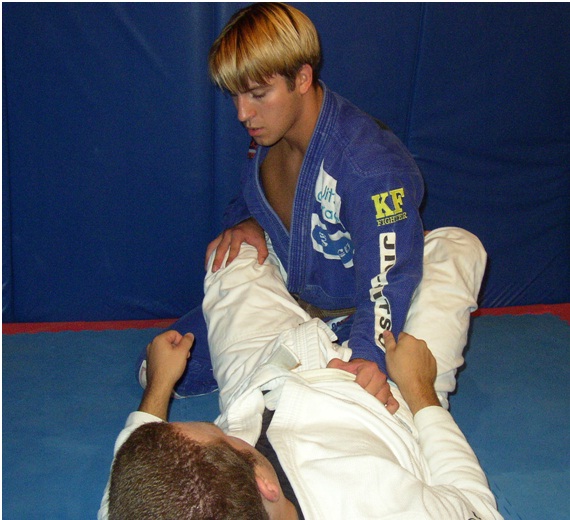
(4.) Tony brings his elbow inside the opponent's
legs and holds the knee with the free hand. The trick to open the guard is
to push the hips downward and rotate your hips back. For example, just like
a door opens up.

(5.) Continue to pass by bringing the arm under the opponent's
leg to the shoulder, and also keep your elbow inside the opponent's legs.

(6.) Hold the collar on the lapel and use pressure towards the head of the
opponent. Here Tony continues to hold the belt; however, you can take it
your off the belt and hold behind the opponent's pants, at the knee or belt
to help pass. Tony's
one knee is on the mat and his other leg steps up to create leverage to
drive forward.
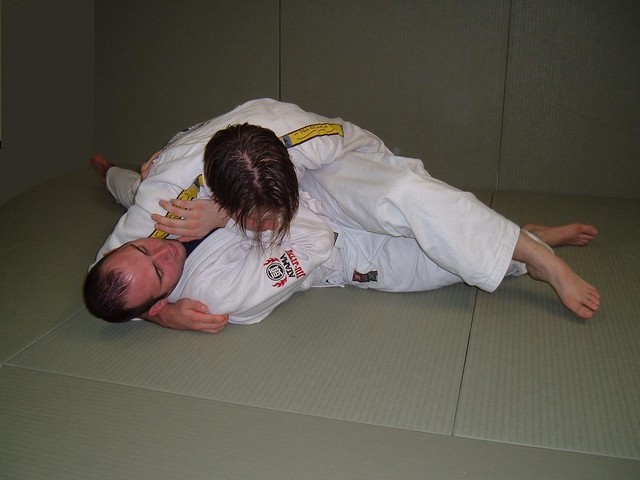
(7.) Letting the leg pass by the head, Tony can now work for the cross body
position or look for other options.
(From the beginning Tony avoided the Triangle Choke Position.)
Ultimately, the main thing is you do put your time in to learn about the guard to understand that movements change and stay the same, and that you have recurrence in your training and learning. You have to be put in the same position over and over again until you find peace there and not struggle in movements of ignorance. You have to learn the difference between a good habit and a bad habit. And that sometimes a bad habit is okay under the right situation. The old saying in Martial Arts is, "Don't confuse the map with the territory." This philosophy applies in those situations. Finally, remember that you are different than your instructor but jiu-jitsu has principles of leverage, technique and strategy that make movements work effortlessly; so use those principles and pass as you wish to. Remember to drill so you can gain sensitivity and muscle memory reflex. But oh yeah, "Don't forget about those foot locks; however, leglocks don't always solve the riddle of passing the guard." And that is another article for sure!
Written by Tony Pacenski 2003
Photos taken by: Jennifer Starson
To Pass or Not To Pass:
Part two- Don't forget about those foot locks!
In part one of To Pass or Not To Pass I wrote about how it is important to learn your own way of applying Brazilian Jiu-Jitsu in what works best for you. By using different methods of passing the guard and mat-time, all students can become effective guard passers outside of their instructor's personal approach and style. I concluded the article by mentioning the idea of leglocks while passing the guard saying, "Leglocks don't always solve the riddle of passing the guard." I would like to look at how the Brazilian Jiu-Jitsu community has in the past looked at leglocks and how one can be effective in using this form of attack in attempting to pass the guard.
I remember when I started Jiu-Jitsu a Brazilian student saying: In Brazil, if you are tapped out by footlock from in the guard, this type of finish is looked down upon. He said that an effective guard pass is better and more skillful than taking the lazy way out by attacking the legs. Out of this former idea one thing is important and will make my point that leglocks do not always solve the riddle of passing the guard. If there are two students that begin to learn how to pass the guard, for example, one taking the time to learn how to pass the guard effectively, and the second always attempting footlocks instead of learning the steps of passing, what is likely to happen? In this situation, one student will become a better guard passer while the other will not, yet he or she did explore leg attacks. Which is better as an instructor for students to learn first?
PASSING THE GUARD EFFECTIVELY
(1.) Starting from the open guard, the opponent holds Tony's ankle and sleeve attempting to bring his leg foot on the hip. Tony holds the opponent's sleeve and uses his elbow & knee to counter the foot on his hip. With the free hand, Tony holds the pants or the ankle of the opponent.
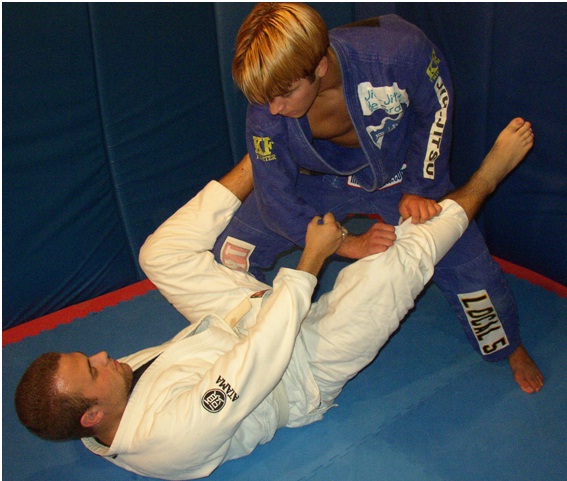
(2.) Choosing to pass the guard, Tony grabs the inside of the opponent's
pant leg.
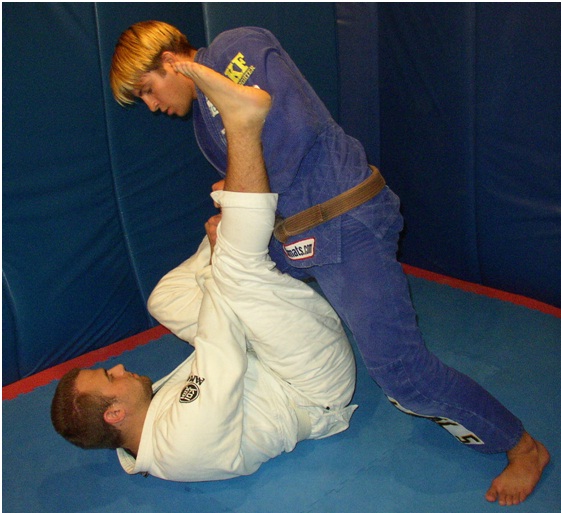
(3.) Tony brings his left elbow behind the opponent's
leg and steps forward for leverage to pass.
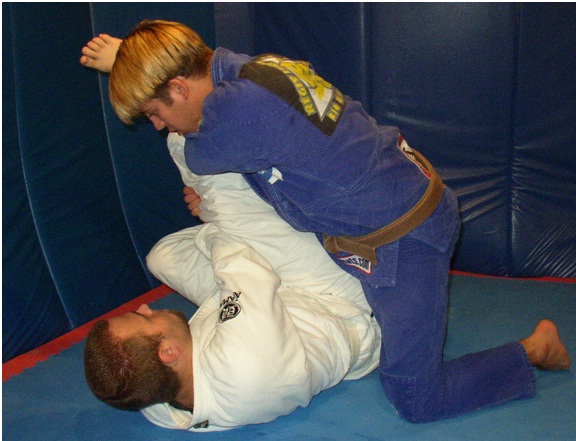
(4.) Moving the legs pass the body, Tony brings his knee to the mat and
uses his hips to create pressure to avoid open space for countering.
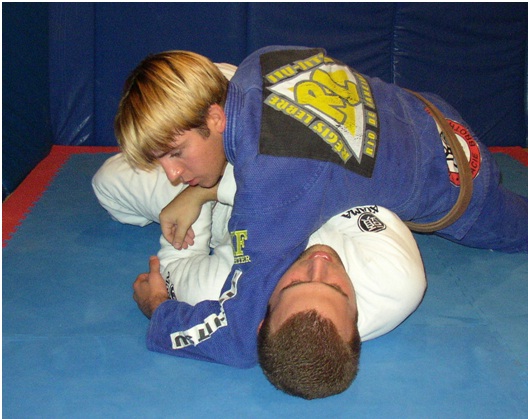
(5.) Tony finalizes in the cross body position looking and feeling for his
next attack.
Personally, when teaching beginners jiu-jitsu on the ground, I feel it is important for them to learn the basic positions such as the guard, mount, and cross side position first. Then, in a later time, these same students will learn submissions attacks. This is not to say that I am attempting to compare apples with oranges. Leglocks while in the guard of an opponent should always be an option never looked down upon in any culture. If the person taps out, you win be it footlock or choke from inside the guard.
Of course, it is important to mention that in the standard Brazilian Jiu-Jitsu rulebook there are fine lines that cannot be crossed when it comes to the topic of leglocks. Depending on your belt level you can only perform a certain number of leg attacks against the opponent in tournament match. For example, a blue belt can only do straight footlocks and not twisting anklelocks or kneelocks; however, if this blue belt brings his own leg over and across the opponent's leg this can result in a DQ when the opponent calls foul. So in essence, if your jiu-jitsu academy teaches by the rulebook, students will be limited in understanding the dynamic of effectively handling how to pass the guard and to me that is not right, although I understand the safety that is involved in tournaments and in the academy when applying leglocks. This brings me to effectively performing a leg attack from inside the guard.
The basic strategy of applying a leglock when inside the guard is to create distance between you and your opponent when his foot/leg is not protected and the ankles are uncrossed. It is difficult to break a foot that is being protected, and without the right timing and leverage the footlock will not exist. Plus, by attacking the leg at the wrong time this can result is losing your position. However, at right time, a good footlock is perfect for winning a match.
USING A LEGLOCK EFFECTIVELY
(1.) Again starting from the open guard, the opponent holds Tony's ankle and sleeve attempting to bring his leg foot on the hip. Tony holds the opponent's sleeve and uses his elbow & knee to counter the foot on his hip. With the free hand, Tony holds the pants or the ankle other opponent.
(2) Having a weak grip on the sleeve, Tony chooses to break the hold using a circular motion with his hand.
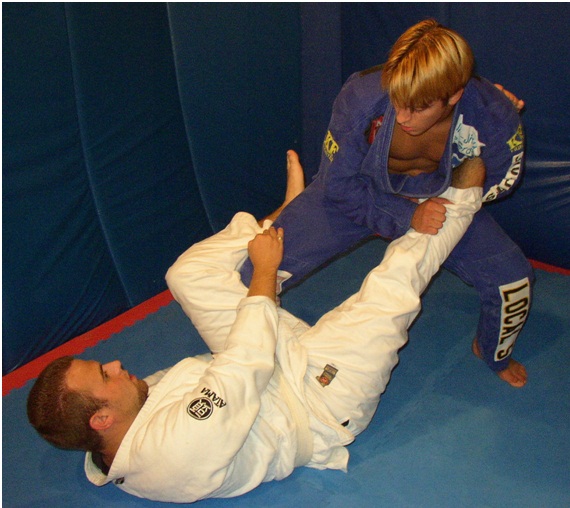 (3.)
Breaking the grip successfully, Tony looks for distance and works the
footlock position. The opponent's hands are no where near Tony's
neck or collar to counter. Tony has the options of sitting down or standing
up to finalize the submission hold.
(3.)
Breaking the grip successfully, Tony looks for distance and works the
footlock position. The opponent's hands are no where near Tony's
neck or collar to counter. Tony has the options of sitting down or standing
up to finalize the submission hold.
Passing or not passing the guard comes down to how you train personally and test yourself with all different body types. During your training and handling of the guard, your personal view should not be a question about being pro-leglocker or pro-guard passer. Your resolve of this manner is how well you combine transitional movements to pass the guard with leglocks to finish the match. You become a pro-finisher adapting and changing with the uniqueness of the situation.
Written by Tony Pacenski 2003
Photos taken by: Jennifer Starson